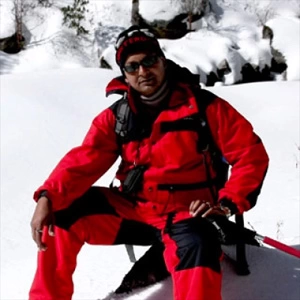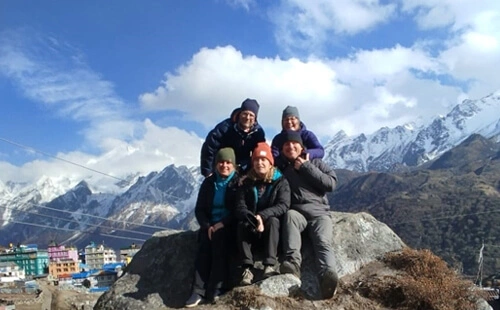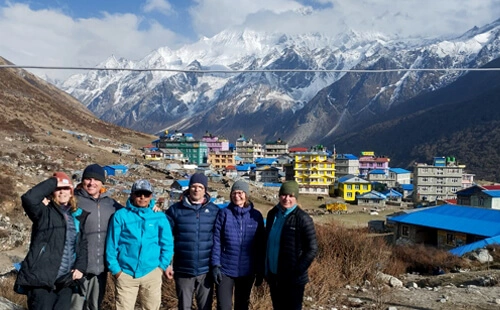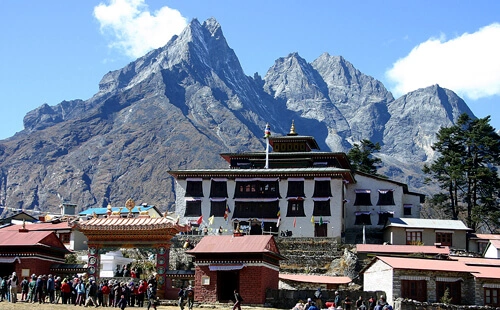Nepal is a land where magnificent mountains, mesmerizing landscape diversity, and rich cultural heritage go hand in hand with providing varied trekking trails for novices and experts, aptly inviting adventurists from the whole world. Eight out of the fourteen tallest mountains in the world lie here, with Mount Everest, the highest top on earth at 8,848 m above sea level; thus, the Everest Base Camp Trek and the Langtang Valley Trek are two of the most remarkable trekking experiences. While both provide an interesting journey to remember for a lifetime, it can be tough to choose between two epic treks. Where we at Adventure Himalayan Travels and Treks present you with a brief discussion on various elements of both treks to help you select the right adventure on the Langtang Valley Trek vs. the Everest Base Camp Trek.
Langtang Valley Trek vs Everest Base Camp Trek: Choose The Right Trek For You
Table of Contents
A Tale of Two Treks: How is Trek to Langtang Valley vs Trek to Everest Base Camp?
Often referred to as the Nepalese Valley of Glaciers, the Langtang Valley is a relatively short yet rewarding trekking destination, an ideal Himalayan voyage for trekkers seeking an off-the-beaten, quick nature escape from hassling city life nearby Kathmandu. It is the easily accessible hidden gem of Nepal to the north of Kathmandu city, taking you through the stunning landscape, charming Tamang villages, and awe-inspiring mountain views. Known for its strong Tibetan-influenced culture and rich cultural experience in the lap of the astounding mountain peak of Langtang Lirung, the Langtang Valley Trek is a scenic, short, and comparatively less strenuous alternative to the Everest Base Camp Trek.
The Everest Base Camp Trek is a classic Himalayan route once followed by legendary mountaineers Sir Edmund Hillary and Tenzing Norgay Sherpa, the first ones to summit Mount Everest successfully. It is a challenging trek, the ultimate epitome of adventure and mountaineering prowess that takes you to the heart of the Everest Himalayas, the foot of the highest peak on the earth, Everest Base Camp (5,364 m/17,598 ft). Officially commencing with an adventurous flight to Lukla’s Tenzing-Hillary airport, noted as one of the most risky airports in the world, it's a bucket list trek for many promising unmatchable views of Everest, insight into Sherpa culture, and a golden chance to stand at Earth’s highest mountain base camp.
Langtang Valley Trek vs Everest Base Camp Trek: Which is more difficult?
When it comes to difficulty, trekkers can find the Everest Base Camp Trek in the Everest Trekking Region in general a bit tougher than trekking to the Langtang Valley. Casually containing for 7 to 10 days, based on trekkers’ walking speed, itinerary chosen, and side trip included, the Langtang Valley Trek is easy, moderately difficult, and doable, including for beginners and intermediate hikers. For the most part, you will walk through a lower elevation than found in the Everest Trekking Trails and reach the highest elevation at Kyanjin Ri (4,773/15,659 ft) or Tsergo Ri (5,033 m/16,512 ft), with low chances of altitude sickness symptoms despite some steep ascents and rocky trails similar to that in the Everest Region.
On the other hand, the Himalayan journey to Everest Base Camp Trek spans longer days traversing higher altitudes and more strenuous rugged terrain. Trekkers are required to be well prepared for changing Himalayan weather, sharp ascents, and descents reaching the altitude of 5,545 m above sea level at Kala Patthar. As you spend more time above 5,000 m during the Everest Base Camp Trek than during the Langtang Valley Trek, there are higher chances of altitude sickness. Therefore, it is a must that you acclimatize properly before ascending too quickly to greater heights.
How does cultural immersion in Langtang Valley Trek differ from cultural encounters on the Everest Base Camp Trek?
Both the Langtang Valley Trek and the Everest Base Camp Trek offer deep cultural immersion, but the trek to Langtang Valley is more about opportunities to interact with local Tamang, while Sherpa and their culture dominate the Everest Himalayas of Nepal. Though both of the indigenous ethnic communities of Nepal share a close cultural tie to Tibetans and are active practitioners of Tibetan Buddhism, showcased by Kyanjin Gompa in the Langtang Valley and Tengboche Monastery in the Everest Himalayas, each of them boasts a unique culture, traditions, attire, and way of life.
To sum it up, though, each trekking destination ensures a rich cultural experience, that of the Sherpa community known for their mountaineering skills during the Everest Base Camp Trekking and that of the Tamang people and the fusion of Buddhism and shamanism on the way to Langtang Valley. However, due to the less commercialization of the Langtang Trek, it provides you with a more authentic cultural experience and encounters, while the EBC trek lets you catch a peek into the historical Sherpa culture and their mountaineering legacy.
What kind of scenery and natural beauty to expect during a Trek to Langtang Valley vs a Trek to Everest Base Camp?
Both treks are in different lands, namely, while the Everest Base Camp Trek is in the Sagarmatha National Park, the Langtang Valley Trek is inside Langtang National Park, yet both take you through mind-blowing and natural beauty on different landscapes. You can expect lush greenery, dense forests of pine and rhododendrons, thundering waterfalls, and shiny glaciers where the Langtang Lirung and many smaller peaks rule the sky horizon in the Langtang Valley Trekking.
Everest Base Camp Trek is famous for its dramatic scenery and enthralling views from Everest, Lhotse, and Ama Dablam, which are some of the highest mountains in the world. The scenery is more diverse as it transitions slowly, with high-altitude deserts, glaciers, and icefalls contrasting sharply with the lush greens of Langtang Valley as one ascends from the subtropical forests in the Khumbu region to Everest's foothills. I.e., if you favor more dramatic mountain views, the Everest Base Camp Trek is for you, while the Langtang Trek is mostly considered for biodiversity.
How is accessibility between Langtang Valley Trek vs Everest Base Camp Trek?
The ease of reaching the trek starting point significantly influences the trekker's choice between Everest Base Camp and Langtang Valley. Having said that, Syabrubesi, in general, is the Langtang Valley Trek starting and ending point around 113 km distance from the Kathmandu Valley and is only a 6-7 hour direct drive, eliminating the potentially risky mountain flight. On the other hand, the Everest Base Camp (EBC) Trek typically commences with a mountain flight to Lukla, which is approximately 138 km away from Kathmandu, and flights are subject to delays, cancellations, and interruptions due to unpredictable Himalayan weather.
Though both are among the best trekking trails in Nepal and offer well-established tea houses, local lodges, and guest houses, providing comfortable accommodations and meals, the Langtang Valley Trek is a great choice for those seeking a more authentic, serene, and intimate trekking experience that remains less traversed even during the peak trekking seasons of Nepal (spring and autumn) when the Everest Base Camp Trekking routes get an influx of tourists at these times.
Why Langtang Valley Trek is a more budget-friendly option to Everest Base Camp Trek?
It is no secret that the total cost of each trek to Langtang Valley vs. Everest Base Camp (EBC) can vary noticeably based on the duration of the trip, level of service chosen, mode of accommodation, and type of operator you are traveling with (local or international); the Langtang Valley Trek in comparison to the Everest Base Camp Trek is more budget-friendly due to several factors. The first and most obvious one is the flight expense. That is, trekkers can ditch the expensive mountain flight on the way to Langtang Valley Trekking, while, for Everest Base Camp Trek, it is almost mandatory that you take a flight to Lukla.
Additionally, other trekking logistics, including accommodation, food, and other amenities on Langtang Valley Trekking Trails, are more affordable, providing the perfect economical choice for trekkers who are mindful of their budget for all sorts of trekkers. But, if you are someone willing to spend more to have a close-up view of the top of the world and even stand at its base, the Everest Base Camp Trek along with other combined trips such as the Everest Base Camp Gokyo Lake via Cho La Pass and the Everest Three High Pass Trek are fantastic options.
Concluding, since the Everest Base Camp Trek in general spans longer days, reaches a higher altitude, and includes more complex logistics than the trek to the Langtang Valley, that is why if you are seeking a more budget-friendly trekking destination in Nepal for 2025 and 2026, the Langtang Valley Trek is worth the investment.
Trek to Langtang Valley vs Trek to Everest Base Camp: which trek is right for you?
By now, you might already have made up your mind on which could be the best adventure for you and where to go between Langtang Valley and Everest Base Camp. If still not physical fitness, time commitment, budget, altitude tolerance, scenery preferences, crowds, and cultural interest are something, you might want to reconsider before booking your trip or officially departing for the journey.
In a nutshell, choose Everest Base Camp (EBC) Trek if you are physically fit, want to experience the iconic Everest region, and Sherpa culture, and stand at the heart of Mount Everest. You are up for the challenge, have ample time, and a budget, and do not mind crowds and potential flight delays. In contrast, if you prefer a shorter, less demanding, affordable, beginner- and family-friendly trekking route, the Langtang Valley trek stands second to none. You will get to embark on less crowded trails with flight uncertainties and fall in love with tranquil landscapes in variations dotted with lush forests, rivers, and mountain vistas.
How to prepare for trekking in Nepal?
Whether you opt for the Langtang Valley Trek, the Everest Base Camp Trek, or shorter treks such as Ghorepani Poon Hill, Mohare Danda, and Khayer Lake, ensuring a successful and seamless experience requires thorough preparation. This preparation encompasses a combination of physical training, appropriate gear and equipment, acclimatization, permits and paperwork, travel insurance, and the right travel companion.
- Physical Preparation: Start training for high altitude several months before your trek to Langtang Valley or Everest Base Camp, focusing on cardiovascular fitness and strength training. It is good to involve yourself in swimming, running, hiking, and cycling to slowly increase the intensity of training if you are planning for the Everest Base Camp Trek. Only good health and physical fitness are prerequisites to participate in the Langtang Valley Trek, there is no requirement to undergo training.
- Trekking gear and equipment: Trekking might be dangerous without quality trekking gear. One ought to have a good pair of trekking shoes, good-quality clothing, and reasonably priced trekking equipment to ensure a safe and reasonably comfortable experience. This includes suitable layered clothing, sturdy hiking boots, sleeping bags, first aid kits, and other essentials. In Kathmandu, particularly in the lively Thamel area, you can find a variety of quality gear at reasonable prices, whether you choose to buy, rent, or borrow. Alternatively, you can bring your own high-quality equipment from home.
- Acclimatization: Acclimatization is key for most successful Himalayan journeys, whether you are traversing to Everest Base Camp or Langtang Valley. It helps to prevent getting altitude sickness so you get to enjoy the Himalayan voyage to the fullest. For it to ascend with the pace, do not rush steps, drink plenty of water, eat healthily, and listen to your body. If symptoms like headaches, nausea, exhaustion, loss of appetite, and vomiting do not ascend further, take a break and recover; if possible, descend to a lower altitude immediately.
- Travel insurance: Life holds unpredictability; on an adventure, the unthinkable creates a memorable experience, whereas trekking and hiking can subject you to serious and minor incidents. This is why purchasing complete travel insurance becomes a must. Make sure the policy you have purchased covers high-altitude trekking (5,000 m above sea level), healthcare expenses, trip delays, cancellations, or lost and stolen possessions, which includes helicopter evacuation.
- Reputable Trekking Agency: For a hassle-free experience, it is always good to trek with licensed trekking companies like Adventure Himalayan Travels and Treks. We arrange all the necessary permits for a seamless and joyful Himalayan journey in advance, saving you time and energy. Our team members are locals from the Himalayas and expert guides and porters who know the route inside and out, whether you embark on the Langtang Valley Trekking route or the Everest Base Camp Trek.
Conclusion
Both treks have no comparison, as both are lifetime incredible journeys in the Nepalese Himalayas. But the Langtang Valley Trek would be iconic for beginners or those who prefer a less-trodden path with mixed scenery that can be further extended up to Tamang Heritage Trail, Langtang Valley Gosaikunda Lake Trekking Route, and Helambu Circuit Hike. On the other side, the Everest Base Camp Trek is made for those dreaming of standing right in front of Everest, ready as mentally as physically to meet the challenges the trek throws.




